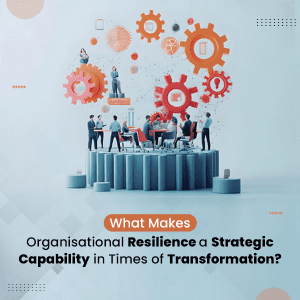
Every change requires a shift in mindset. People don’t change their behaviors without changing their beliefs and their willingness to engage in the change. But what happens when a toxic group doesn’t want to work with you during a change? Or when your perspectives about the working relationship are misaligned? Or after a painful merger with job cuts and people working with a completely new culture? Culture changes are unique and difficult, and success only comes when you build trust.
Culture and Culture Change
What is “organizational culture”? It is often said that culture is what happens when leaders leave the room. Culture is what you see in the behavior and attitudes of your organization’s people. A culture change first happens in people’s heads, and then it is represented in behaviors that demonstrate the culture.
There are many types of culture changes. The return to the workplace is a common culture change Prosci Change Advisors work on with clients today. Some organizations with standard in-person office cultures have been rocked to the core because they had no opportunity for flexibility or to work from home until COVID-19 changed everything.
Diversity, Equity, and Inclusion (DE&I) changes have also become prominent. With the events that happened over the last 18 months in the U.S., organizations around the world are seeing that it is necessary to be more inclusive, and there needs to be more equity around that inclusion.
Mergers and acquisitions can be the catalyst for another type of culture change, which impacts people who were not made redundant and must now work in a completely different culture. In these situations, the merger often goes very smoothly and looks complementary at the senior level but falters with impacted people and teams.
Why managing culture change effectively is critical
Culture changes can be deceptively complex. They often need careful management to achieve good results—and avoid potentially serious problems. I once worked on a client merger between two banks with complementary services. Operationally and strategically, the fit was very good. But four years later, people still mentally considered themselves employees of one or the other banks and never really merged at the branch level.
Why? One reason was that branch leadership was replaced by people from the sales-oriented bank. As a result, employees from the lending- and credit-focused bank felt like they weren’t valued anymore and that they’d been pushed down in the organization. Although a merger impacts everyone, if what is valued gets amplified and what is not valued gets downplayed, we see employee disengagement, unhappiness, reduced performance, and turnover.
Ensuring that everyone is inculcated into the new culture is important. We don’t want employees to be disengaged, retired in place, and just giving up on the job. And that can easily happen if we don’t have the empathy to stand in the shoes of the people who feel less valued.
How to manage culture change to build trust
To start managing a cultural change, you first need to be very, very clear about what good looks like and not just at a theoretical level. It’s not about people being nice to each other and supportive and collaborative. That’s all very well, but if we walked into that organization where a culture change had been successful, what behaviors would we see? And what environment would we see because of those behaviors?
With a culture change, it’s critical to remember:
- The environment is created by the behaviors.
- Behaviors are driven by the capability to display those behaviors.
- And the capability is driven by the belief that it’s OK to do those things in this organization.
Let’s say you want to encourage work-life balance, but when you see people taking time off during the middle of the day to go to the gym, someone asks, “What the heck are you doing going to the gym during work hours?” That question destroys the capability to exhibit the required behavior to achieve work-life balance.
But what if my organizational leaders encourage me to work the hours that give me a work-life balance? If I start to work early or work late because a client needs me to, I can go to the gym for two hours in the middle of the day without issue. Most importantly, my behavior is driven by the belief that I will not be penalized for exhibiting the behaviors I’m being asked to display. I must have a belief and trust in the organization. Without that, I wouldn’t feel I have the capability, so I wouldn’t exhibit those behaviors, and the environment would be less trusting. It comes down to evidence: “I’ll believe it when I see it!”
When Prosci Change Advisors work with organizations on culture changes, we help them identify what they need people to believe, how to speak to those beliefs, and how to exhibit the behaviors and work up to the belief system.
Going back to the work-life balance example, a CEO might share his personal calendar, which shows he takes his kids to school in the morning and eats lunch with a family member. That trust-building behavior encourages others to open up about how they flex their time to prioritize their health, care for family members, or manage their own work-life balance. Those successes are supported and encouraged when you publicly celebrate people adopting the new behaviors. And you help those who are not adopting the new behaviors to identify the barrier point that’s making them struggle to give themselves permission to adopt the change.
Successful culture change is in large part about building trust. Trust is difficult because it’s based on past experience, slow to build, and easy to wipe out. The focus for any people leader taking an organization through change is to act on those items that are counter to the new culture very quickly, so they’re not seen as being tolerated. That’s hard work. That’s unpleasant. You’ve got to have difficult conversations, but you’ve also got to make it clear that’s not the way we do things anymore.
Effective Culture Change Brings Trust and Benefits
The outcome from a culture change isn’t always what people expect, especially if a culture is toxic. You probably won’t go from a toxic culture to nirvana. It might be that you’re just moving from toxic to acceptable. But that’s beneficial because it will enable you to attract quality people who want to help you finish the journey. When there is something toxic going on, we must seek to understand then to be understood. This helps build the trust you need to make any culture change real. True culture changes always bring me back to a Mark Twain quote: “It ain’t what you don’t know that gets you into trouble. It’s what you know for sure that just ain’t so.”






